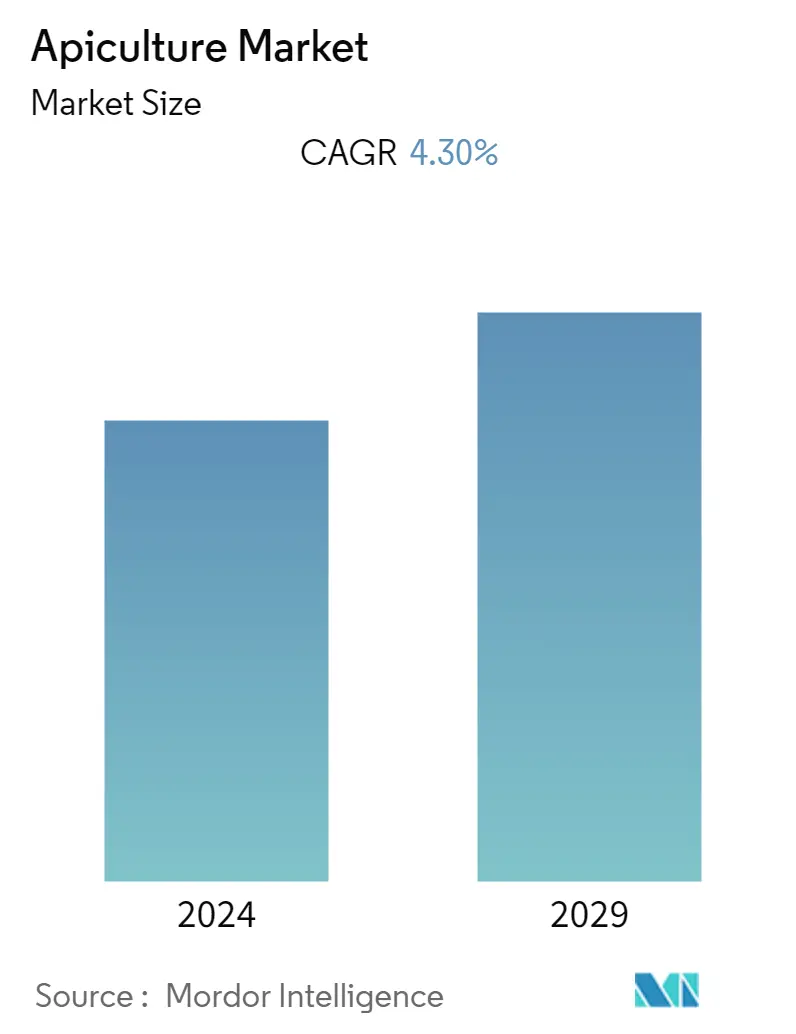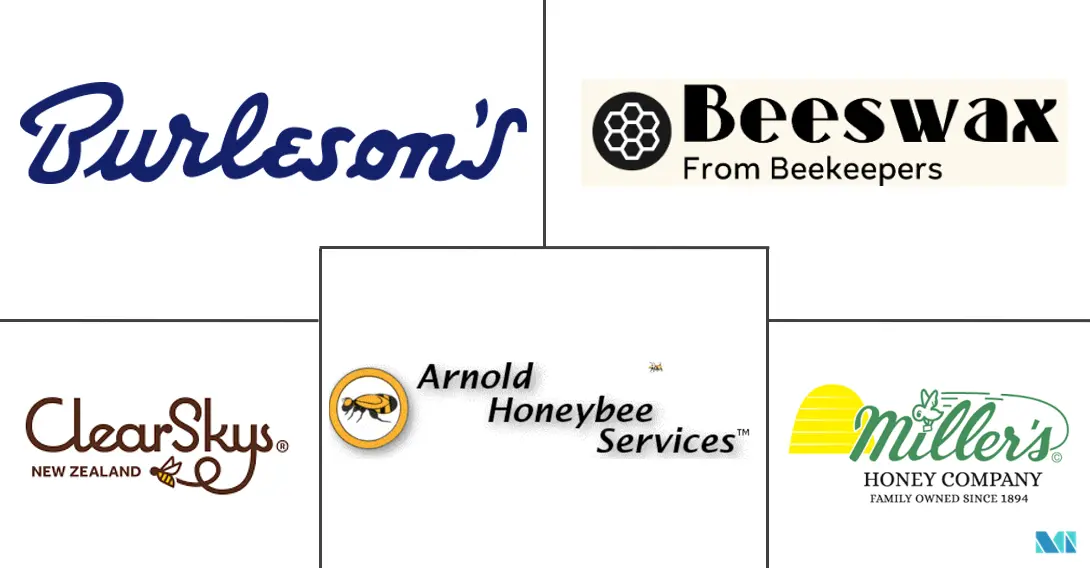Market Size of Apiculture Industry

| Study Period | 2019 - 2029 |
| Base Year For Estimation | 2023 |
| CAGR | 4.30 % |
| Fastest Growing Market | North America |
| Largest Market | Asia Pacific |
| Market Concentration | Low |
Major Players
*Disclaimer: Major Players sorted in no particular order |
Apiculture Market Analysis
The global apiculture market is estimated to register a CAGR of 4.3% during the forecast period.
- Commercial beekeeping farming will come into the picture as the demand for apiculture products from various industries increases due to medicinal and cosmetic purposes, further driving the apiculture market. The benefits associated with apiculture rearing are low maintenance and cost-effectiveness.
- The increasing demand for honey, beeswax, and other byproducts in developing countries is expected to boost the global market during the forecast period. Europe and North America have a significant consumption share of products like propolis, honey, and other products, while rapid growth has been projected in the Asia-Pacific regions. Support for organic agriculture has been rising, with many organizations like National Beekeepers Association and the National Organic Value chain Association extending their support toward organic agriculture. This trend has led to a rise in pollination demand, which boosts the apiculture market.
- Consumers have become more health conscious; many customers are demanding more natural sweeteners like honey than sugar. Honey is considered a healthier way to sweeten food and beverages as honey contains about 75-80% sugar, and the rest is a mixture of water and minerals like phosphorous, calcium, magnesium, some acids, and enzymes. Therefore, health benefits associated with honey are expected to increase the demand for honey in the global market.
- Artificial sweeteners may result in obesity, elevated cholesterol, mineral depletion, tooth decay, hypertension, and cardiovascular diseases. These sweeteners are also responsible for Type 2 diabetes, metabolic syndrome, cancers, and tumors. On the other hand, honey has a low glycemic index (GI), meaning it does not immediately elevate blood sugar levels. It's also high in antioxidants, which have numerous human health benefits.
- Additionally, propolis is a resinous substance that bees accumulate from different plant types. Propolis is widely used in numerous applications due to its antiseptic, anti-inflammatory, antioxidant, antifungal, anti-cancer, and immunomodulatory properties. However, the market is primarily driven by its use as a healing product for cold sores and herpes caused due to the herpes simplex virus (type 1 and type 2). The wide range of applications of apiculture products has been driving the market studied.
Apiculture Industry Segmentation
The practice of raising honeybees is known as apiculture. Apiculture is carried out for the commercial production of honey as well as other useful commodities like beeswax, and other such products.
In this study, only commercial apiculture feed has been considered. The report consists of an extensive study of the segments and factors driving the growth of the apiculture market. The market is segmented by product type, application, and by geography. By product type, the market is segmented into honey, beeswax, live bee, and other product types. Based on application, the market is segmented into medical, food, beverages, cosmetics, and other applications. The study also covers the global level analysis of major regions, such as North America, Europe, Asia-Pacific, South America, the Middle East & Africa.
For each segment, the market sizing and forecasts have been done on the basis of value (in USD million).
| Product Type | |
| Honey | |
| Beeswax | |
| Live-bees | |
| Others |
| Application | |
| Medical | |
| Food Beverages | |
| Cosmetics | |
| Others |
| Geography | ||||||||
| ||||||||
| ||||||||
| ||||||||
| ||||||||
|
Apiculture Market Size Summary
The global apiculture market is poised for steady growth, driven by increasing demand for honey, beeswax, and other byproducts, particularly in developing regions. The market is benefiting from the rising popularity of natural sweeteners like honey, which is favored for its health benefits over artificial alternatives. This trend is further supported by the growing consumer preference for organic and chemical-free products, bolstered by endorsements from organizations such as the National Beekeepers Association. The market's expansion is also fueled by the diverse applications of apiculture products in the medicinal and cosmetic industries, with honey and propolis gaining traction for their therapeutic properties. The Asia-Pacific region, led by China, is a significant player in the market, with increasing consumption and export of apiculture products.
The apiculture market is characterized by its fragmented nature, with numerous beekeeping firms globally. Major industry players are focusing on strategic expansions and acquisitions to enhance their market presence. Companies like Clearskys, Arnold Honey Bee Services, and Burleson's Honey are actively pursuing growth opportunities. Recent developments include mergers and the establishment of new facilities to support product innovation and sustainability efforts. The market's growth trajectory is supported by the increasing adoption of apiculture products in health care, cosmetics, and food industries, highlighting the sector's potential for continued expansion in the coming years.
Apiculture Market Size - Table of Contents
-
1. MARKET DYNAMICS
-
1.1 Market Drivers
-
1.2 Market Restraints
-
1.3 Industry Attractiveness - Porter's Five Forces Analysis
-
1.3.1 Threat of New Entrants
-
1.3.2 Bargaining Power of Buyers/Consumers
-
1.3.3 Bargaining Power of Suppliers
-
1.3.4 Threat of Substitute Products
-
1.3.5 Intensity of Competitive Rivalry
-
-
-
2. MARKET SEGMENTATION
-
2.1 Product Type
-
2.1.1 Honey
-
2.1.2 Beeswax
-
2.1.3 Live-bees
-
2.1.4 Others
-
-
2.2 Application
-
2.2.1 Medical
-
2.2.2 Food Beverages
-
2.2.3 Cosmetics
-
2.2.4 Others
-
-
2.3 Geography
-
2.3.1 North America
-
2.3.1.1 United States
-
2.3.1.2 Canada
-
2.3.1.3 Mexico
-
2.3.1.4 Rest of North America
-
-
2.3.2 Europe
-
2.3.2.1 Germany
-
2.3.2.2 United Kingdom
-
2.3.2.3 France
-
2.3.2.4 Russia
-
2.3.2.5 Spain
-
2.3.2.6 Rest of Europe
-
-
2.3.3 Asia Pacific
-
2.3.3.1 China
-
2.3.3.2 Japan
-
2.3.3.3 India
-
2.3.3.4 South Korea
-
2.3.3.5 Rest of Asia-Pacific
-
-
2.3.4 South America
-
2.3.4.1 Brazil
-
2.3.4.2 Argentina
-
2.3.4.3 Rest of South America
-
-
2.3.5 Middle-East and Africa
-
2.3.5.1 United Arab Emirates
-
2.3.5.2 South Africa
-
2.3.5.3 Rest of Middle-East and Africa
-
-
-
Apiculture Market Size FAQs
What is the current Apiculture Market size?
The Apiculture Market is projected to register a CAGR of 4.30% during the forecast period (2024-2029)
Who are the key players in Apiculture Market?
Arnold honey bee services, Beeswax From Beekeepers, Millers Honey, Burleson's Honey and Clearskys are the major companies operating in the Apiculture Market.

